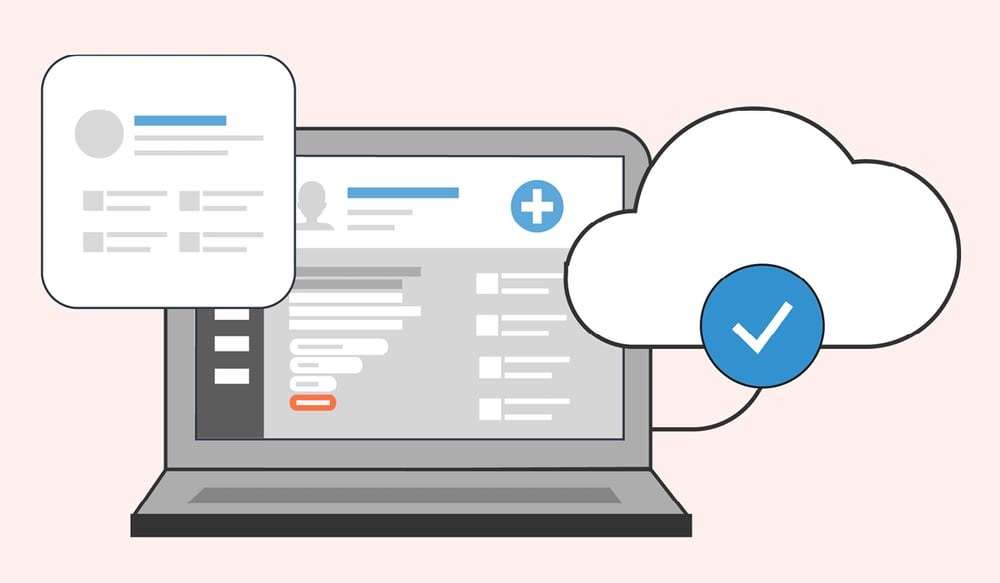In recent years, healthcare provider organizations of all sizes have joined large health systems in transitioning to cloud-based software for safety, quality, risk management, and other applications. This is because cloud computing in healthcare offers tremendous advantages to small private practices, multi-location hospital networks, and independent treatment facilities alike.
Virtually every sized healthcare facility can take advantage of benefits, such as reducing costs, enhancing privacy, and most importantly, fostering patient safety and quality initiatives by leveraging cloud software technologies.
What is cloud computing in healthcare?
In the broader sense, cloud computing in healthcare refers to the implementation of remote servers. These off-site IT resources are accessed via a high-speed internet connection.
Healthcare organizations can use these servers to manage, store, and process data related to the patients they serve and the services they provide, including information technology management for:
- Provider data
- Directory and patient-facing data
- Quality, risk, and compliance data
- Patient safety tools including incident reporting forms, complaints, and suggestion forms, and surveys
The alternative options are to establish a robust on-site data center or to host data on individual computers. Creating an on-site data center is incredibly costly compared with employing a hosted or cloud-based application—also referred to as software as a service (Saas). In addition, data housed locally on personal devices can compromise the security of patient and provider performance information and diminish the care experience.
Security is more than just user privileges and password policies. It’s a multidimensional business imperative. Companies such as The Patient Safety Company that deliver convenient cloud computing options maintain detailed, rock-solid policies, processes, and procedures in place to deliver the highest levels of security.
Cloud computing in healthcare provides organizations with a unique balance of security, data-sharing capabilities, and scalability. It is more cost-effective than on-site data centers and substantially more secure than hosting data on personal computers.
How is cloud computing changing the healthcare industry?
Cloud computing in healthcare is revolutionizing the entire industry. This technology allows providers within and between organizations to share data safely and efficiently. The result is a safer patient experience and improved outcomes, which increasingly affect reimbursement. For example, providers are able to use this technology to expedite the reimbursement process and improve against internal and external quality targets, which include key performance indicators for safety and compliance, such as hand hygiene, fall prevention, and more.
In addition, cloud computing enables collaboration in a modern environment. Working from any facility or site and importing/exporting data and documents from anywhere, via any electronic device, is a scenario that’s here to stay. Cloud technology secures information and enables remote connectivity for any user, including providers and staff, with any level of permissions granted.
Effective patient safety and continuous quality improvement efforts that result in fewer incidents will require readily available tools for:
- Transparency and disclosure
- Improved data collection and analysis
- Development of effective systems at the level of direct patient care
Cloud computing checks all of these boxes.
The Patient Safety Company’s cloud-based tools facilitate the completion and submission of documents required for creating a culture of continuous improvement via a secure website, eliminate or minimize paper processes, and provide an efficient and secure way to share and reuse data in your system.
COVID-19’s impact on cloud adoption
The COVID-19 pandemic accelerated the adoption of cloud computing in healthcare. Between the rush to develop a viable vaccine and the need to expand caregiving capabilities, healthcare organizations were thrust into an accelerated timeline to acquire and share data. In response, many entities adopted vertical cloud solutions that are designed to accommodate the unique needs of healthcare providers. Cloud computing companies that focus only on healthcare had a leg up because they were already adept at incorporating safety, privacy, and performance improvement.
These technologies facilitate AI-based development and research, telehealth services, and crisis management protocols while simultaneously maintaining compliance with government and other regulators.
Types of cloud computing in healthcare
Cloud computing in healthcare can generally be divided into two broad models. These types of cloud computing solutions include:
Deployment model: There are four cloud deployment models: public clouds, private clouds, community clouds, and hybrid clouds. The exact deployment model chosen will depend on the specific needs of the industry.
For the healthcare industry, a private cloud or hybrid cloud deployment is the ideal solution. Private clouds are excellent for healthcare organizations due to the stringent patient data restrictions established through regulatory requirements.
Distribution model: A distribution model leverages dispersed data centers and multiple points of presence (PoPs). Each location has edge devices and leverages the architecture established by existing clouds.
The distribution model places an increased emphasis on extending services to customer data centers and edge devices. The cloud provider is responsible for the maintenance, operation, governance, and updating of the distribution model.
As organizations gravitate to hosted environments for all types of healthcare applications, decision-makers naturally want to be sure about safety, performance, and control when moving from on-premises applications. As a result, the selection of the most appropriate, safety-oriented model is necessary.
What are the benefits of cloud computing in the healthcare industry?
There are eight key benefits to the implementation of cloud computing solutions, which include the following:
- Scalability and flexibility: Storing mass amounts of patient data using on-site hardware limits an organization’s scalability. Conversely, cloud computing solutions provide healthcare organizations with superior scalability at a reduced cost. Storage capabilities can be increased as the healthcare organization’s needs grow.
Cloud computing in healthcare is not only a more scalable solution, but also provides hospitals with increased fiscal flexibility. When implementing data centers, the organization must attempt to estimate how many servers they will need and invest in these solutions accordingly. This requires a massive upfront investment. Cloud computing solutions do not require any large initial investment. Instead, healthcare providers can pay as they go. They need not tie up hundreds of thousands of dollars in servers and other hardware. - Data storage and data loss prevention: Data loss due to a server failure, natural disaster, or another unexpected event can be detrimental to a healthcare organization’s bottom line. To compound matters, a massive data loss means that providers lose valuable patient care records, which can compromise client safety.
Cloud computing in healthcare offers exceptional data-loss prevention protections. Valuable data is stored off-site, but these files can be backed up and readily recovered in the event of a catastrophic equipment failure. - Security: In recent years, governments and other regulators have placed an increased emphasis on data security. As a result, healthcare providers are faced with extremely stringent regulations regarding patient data. If they fail to take adequate measures to protect this confidential information, healthcare organizations can face hefty fines and long-term damage to their reputation.
While healthcare organizations can handle cybersecurity in-house, outsourcing data management and protection to cloud providers is the more pragmatic solution. These entities can provide storage of electronic health records (EHRs) that comply with legal guidelines for security and privacy. - Collaboration: A lack of communication between physicians and other medical staff can be a huge issue in terms of patient care and safety. This is an especially concerning problem when a patient is transferred to a different wing or floor of a large care facility such as a hospital.
Inefficient data sharing practices diminishes the overall quality of care and also prevent providers from producing optimal patient outcomes. Cloud software in the healthcare setting facilitates streamlined collaboration between all members. These solutions include workforce management technologies, charting tools, data sharing capabilities, and other functions that substantially improve the quality of patient care. Enhanced collaboration also helps to protect the providers from civil liability. - AI and machine learning: Innovative cloud solutions leverage the latest artificial intelligence and machine learning capabilities. These technologies positively impact every facet of the healthcare process. Machine learning allows providers to automate redundant processes involved in recordkeeping. This can reduce administrative costs, optimize daily operations, and most importantly, improve the patient care experience.
Machine learning and AI will also benefit data integrity by limiting errors and improving the accuracy of patient information. AI and machine learning include predictive analytics capabilities, as well. This analytic data can reveal insights about how providers can improve the patient care experience, eliminate inefficiencies, and cut costs. - Disaster recovery: Cloud computing resources assist in data recovery, but these technologies also help providers to resume normal operations with greater speed after a disaster, whether it’s natural or man-made, wherein there’s an increased demand for health services. Even a brief outage in IT resources can leave hospitals unable to provide adequate levels of care.
- Speed: Cloud computing in healthcare increases the efficiency of every facet of the patient care lifecycle. Organizations that use cloud software will be able to rapidly process patients; monitor for safety and quality; analyze, report on, and mitigate incidents and risks; more efficiently bill insurers; and quickly relay information between providers.
In addition, speeding up redundant processes means that the staff teams will have fewer demands on their valuable time. They will have more time to focus on dynamic tasks that require their full attention. - Patient care and safety: Transitioning to cloud-based EHRs has the ability to drastically enhance patient safety. Cloud solutions allow providers across various facilities to gain valuable insights into past interactions between patients and other physicians. This will protect patients, for example, from being prescribed excessive medications.
Today’s incident management methods require more than tracking incidents or near incidents at the hospital bedside. As practitioners increasingly administer care and services in outpatient, ambulatory, or retail clinics; in specialty centers; and via telemedicine, our safety and quality improvement tools must adapt. In other words, we must follow the patient to prevent harm. Cloud forms are easy to use and accessible by computer, tablet, or smartphone to increase participation and compliance, and to capture details that can become lost as time passes.
Are there challenges to cloud adoption in healthcare?
As with any new technology, there are challenges associated with the widespread adoption of cloud computing in healthcare. At the forefront of these obstacles are concerns regarding the confidentiality and security of cloud-based computing solutions. Some facilities and providers are worried that cloud-based data storage does not offer an adequate protection of confidential patient or provider information.
However, the majority of these concerns are unfounded. In fact, cloud-based storage is far safer than traditional recordkeeping methods involving physical patient files or the use of personal computers. By implementing strong application security practices such as encryption-in-transit, encryption-at-rest, robust authentication and authorization mechanisms, and defense-in-depth controls, cloud computing keeps data safe and in the hands of the right parties.
The future of healthcare organizations with cloud computing
Cloud computing is a valuable resource for healthcare organizations but will require the selection of the right cloud services provider.
The Patient Safety Company specializes in cloud solutions for healthcare. Our firm understands the unique needs of providers, hospitals, and physicians’ groups. We have earned the trust of over 6,000 hospitals and health systems across the globe by helping them navigate the complexities of healthcare operations.
For example, one of our clients with facilities in Southern Africa, Middle East en Europe is collecting data on 3 different cloud locations. This multi cloud solution enables them to combine relevant data for incident analysis and still comply to local privacy regulations.
If you would like to learn more about our innovative suite of SaaS solutions for improving patient safety, contact us today. You can even schedule a demo and see our integrated healthcare technologies firsthand.


%20(3)%20(1).jpg)


